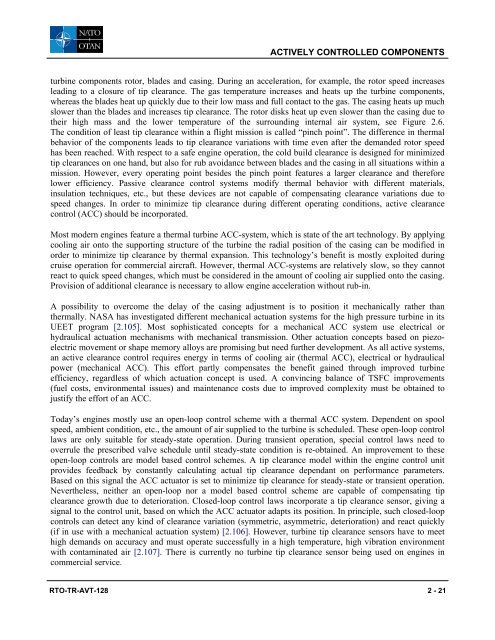More Intelligent Gas Turbine Engines - FTP Directory Listing - Nato
More Intelligent Gas Turbine Engines - FTP Directory Listing - Nato
More Intelligent Gas Turbine Engines - FTP Directory Listing - Nato
Create successful ePaper yourself
Turn your PDF publications into a flip-book with our unique Google optimized e-Paper software.
ACTIVELY CONTROLLED COMPONENTS<br />
turbine components rotor, blades and casing. During an acceleration, for example, the rotor speed increases<br />
leading to a closure of tip clearance. The gas temperature increases and heats up the turbine components,<br />
whereas the blades heat up quickly due to their low mass and full contact to the gas. The casing heats up much<br />
slower than the blades and increases tip clearance. The rotor disks heat up even slower than the casing due to<br />
their high mass and the lower temperature of the surrounding internal air system, see Figure 2.6.<br />
The condition of least tip clearance within a flight mission is called “pinch point”. The difference in thermal<br />
behavior of the components leads to tip clearance variations with time even after the demanded rotor speed<br />
has been reached. With respect to a safe engine operation, the cold build clearance is designed for minimized<br />
tip clearances on one hand, but also for rub avoidance between blades and the casing in all situations within a<br />
mission. However, every operating point besides the pinch point features a larger clearance and therefore<br />
lower efficiency. Passive clearance control systems modify thermal behavior with different materials,<br />
insulation techniques, etc., but these devices are not capable of compensating clearance variations due to<br />
speed changes. In order to minimize tip clearance during different operating conditions, active clearance<br />
control (ACC) should be incorporated.<br />
Most modern engines feature a thermal turbine ACC-system, which is state of the art technology. By applying<br />
cooling air onto the supporting structure of the turbine the radial position of the casing can be modified in<br />
order to minimize tip clearance by thermal expansion. This technology’s benefit is mostly exploited during<br />
cruise operation for commercial aircraft. However, thermal ACC-systems are relatively slow, so they cannot<br />
react to quick speed changes, which must be considered in the amount of cooling air supplied onto the casing.<br />
Provision of additional clearance is necessary to allow engine acceleration without rub-in.<br />
A possibility to overcome the delay of the casing adjustment is to position it mechanically rather than<br />
thermally. NASA has investigated different mechanical actuation systems for the high pressure turbine in its<br />
UEET program [2.105]. Most sophisticated concepts for a mechanical ACC system use electrical or<br />
hydraulical actuation mechanisms with mechanical transmission. Other actuation concepts based on piezoelectric<br />
movement or shape memory alloys are promising but need further development. As all active systems,<br />
an active clearance control requires energy in terms of cooling air (thermal ACC), electrical or hydraulical<br />
power (mechanical ACC). This effort partly compensates the benefit gained through improved turbine<br />
efficiency, regardless of which actuation concept is used. A convincing balance of TSFC improvements<br />
(fuel costs, environmental issues) and maintenance costs due to improved complexity must be obtained to<br />
justify the effort of an ACC.<br />
Today’s engines mostly use an open-loop control scheme with a thermal ACC system. Dependent on spool<br />
speed, ambient condition, etc., the amount of air supplied to the turbine is scheduled. These open-loop control<br />
laws are only suitable for steady-state operation. During transient operation, special control laws need to<br />
overrule the prescribed valve schedule until steady-state condition is re-obtained. An improvement to these<br />
open-loop controls are model based control schemes. A tip clearance model within the engine control unit<br />
provides feedback by constantly calculating actual tip clearance dependant on performance parameters.<br />
Based on this signal the ACC actuator is set to minimize tip clearance for steady-state or transient operation.<br />
Nevertheless, neither an open-loop nor a model based control scheme are capable of compensating tip<br />
clearance growth due to deterioration. Closed-loop control laws incorporate a tip clearance sensor, giving a<br />
signal to the control unit, based on which the ACC actuator adapts its position. In principle, such closed-loop<br />
controls can detect any kind of clearance variation (symmetric, asymmetric, deterioration) and react quickly<br />
(if in use with a mechanical actuation system) [2.106]. However, turbine tip clearance sensors have to meet<br />
high demands on accuracy and must operate successfully in a high temperature, high vibration environment<br />
with contaminated air [2.107]. There is currently no turbine tip clearance sensor being used on engines in<br />
commercial service.<br />
RTO-TR-AVT-128 2 - 21

















